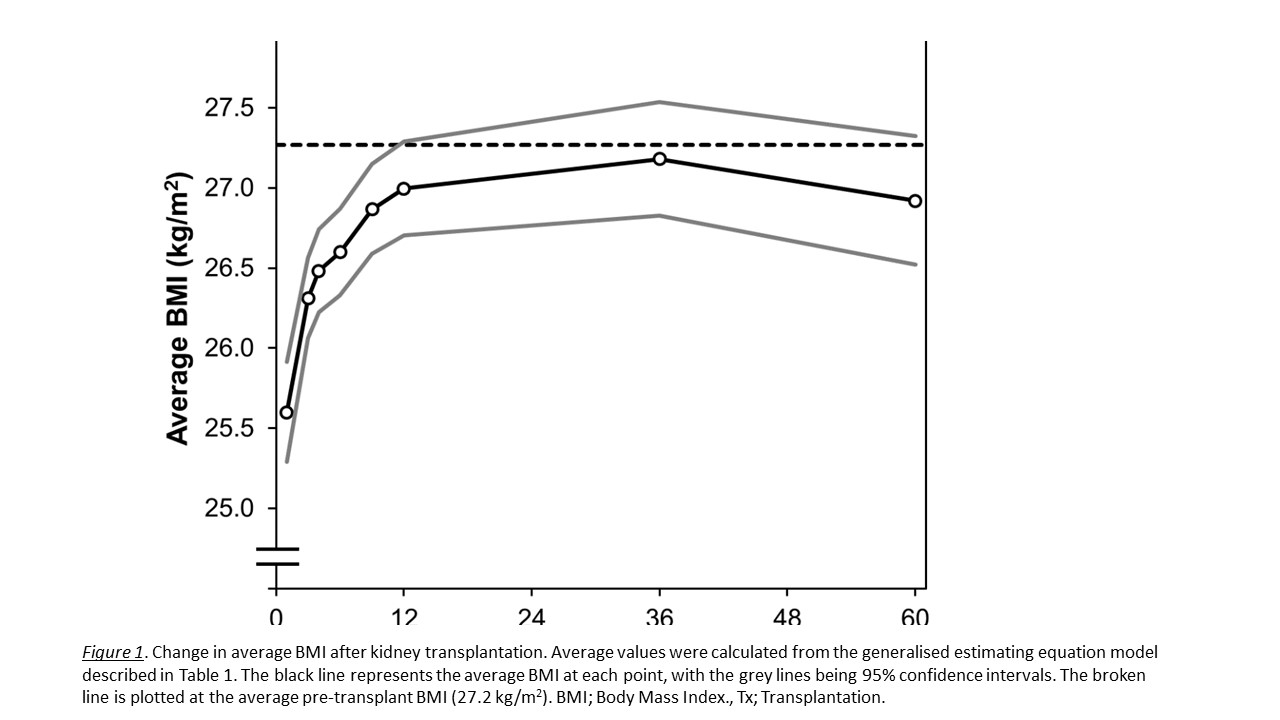Changes in Body Mass Index and Outcomes after Kidney Transplantation: A Single Centre, Retrospective, Observational Study
1University of Birmingham, Birmingham, United Kingdom, 2Queen Elizabeth Hospital, Edgbaston, Birmingham, UK, Institute of Translational Medicine, Birmingham, United Kingdom, 3Queen Elizabeth Hospital Birmingham, UK, Department of Nephrology and Transplantation, Birmingham, United Kingdom
Meeting: 2019 American Transplant Congress
Abstract number: C74
Keywords: Kidney transplantation, Weight
Session Information
Session Name: Poster Session C: Kidney Complications: Late Graft Failure
Session Type: Poster Session
Date: Monday, June 3, 2019
Session Time: 6:00pm-7:00pm
 Presentation Time: 6:00pm-7:00pm
Presentation Time: 6:00pm-7:00pm
Location: Hall C & D
*Purpose: The aim of this study was to describe the changes in body mass index (BMI) after kidney transplantation and assess how this influences long-term outcomes.
*Methods: Data were collected for all kidney transplant recipients between January 2007 and July 2016. Changes in BMI over the post-transplant period were modelled using a generalised estimating equation. The change in BMI from pre-transplantation to six months was then calculated for each patient. These were categorised into three groups: stable BMI (a change of ±1.5 kg/m2), BMI reduction and BMI increase (changes of >1.5 kg/m2), between which a range of outcomes were compared.
*Results: Data was available for 1,344 patients, who had a geometric mean pre-transplant BMI of 27.3 kg/m2. This declined significantly (P<0.001), to a geometric mean of 25.6 kg/m2 one month after transplantation, before increasing and stabilising to pre-transplant levels by 36 months (geometric mean 27.2 kg/m2, P=0.522) (Figure 1). The n=882 patients with BMI measurements at six months, were divided into groups of reduced (n=303), stable (n=388) and increased (n=131) BMI, relative to pre-transplantation levels. On multivariate analysis, 12-month creatinine levels were significantly higher in the BMI reduction cohort, with adjusted levels of 160.6 μmol/l, compared to 135.0 μmol/l in stable BMI. However, no significant associations were detected between six-month BMI change and patient survival, graft survival, incidence of post-transplant diabetes, cancer, or a range of clinical and histological outcomes (all P>0.05).
*Conclusions: Our data demonstrates that BMI significantly reduces in the first month after kidney transplantation, before increasing to pre-transplant levels at 3-5 years. Furthermore, patients with decreasing BMI at six-months have impaired graft function in the long-term. These observations conflict with the existing literature and warrant further investigation
To cite this abstract in AMA style:
Arshad A, Hodson J, Khalil K, Sharif A. Changes in Body Mass Index and Outcomes after Kidney Transplantation: A Single Centre, Retrospective, Observational Study [abstract]. Am J Transplant. 2019; 19 (suppl 3). https://atcmeetingabstracts.com/abstract/changes-in-body-mass-index-and-outcomes-after-kidney-transplantation-a-single-centre-retrospective-observational-study/. Accessed July 3, 2025.« Back to 2019 American Transplant Congress

